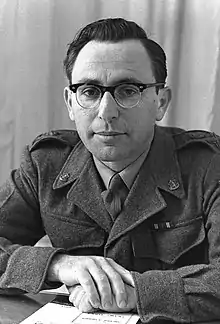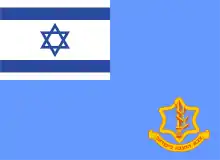Tzvi Tzur
Tzvi Tzur (Hebrew: צבי צור, also transliterated Zvi Tsur, 1923 – 28 December 2004) was an Israeli officer who served as the IDF's 6th Chief of Staff.
Tzvi Tzur | |
|---|---|
 Tzvi Tzur in 1955 | |
| Faction represented in the Knesset | |
| 1965 | Rafi |
| Personal details | |
| Born | 1923 Zaslav, Soviet Union |
| Died | 28 December 2004 Israel |
| Military service | |
| Allegiance | British Army Haganah Israel Defense Forces |
| Years of service | 1936–1963 |
| Rank | (Chief of Staff) |
| Battles/wars | 1948 Arab–Israeli War Suez Crisis |
Biography
Early life
Tzur was born in the Zaslav in the Soviet Union (now Iziaslav in Ukraine) in 1923, as Tsvi Tsera Tsertenko, and made aliyah to Mandatory Palestine at the age of two. In 1936, at the peak of the Arab revolt and the 1936–1939 pogroms he joined the Haganah in order to help protect the Jews from Arab rioters.
Military career
With the outbreak of the 1948 Arab-Israeli War, Tzur was appointed battalion leader in the Givati Brigade, and participated in Operation Pleshet, among others. Tzur was the founder of the fast jeep reconnaissance company, Samson's Foxes, which fought on the southern front. After the end of the war, he undertook organizing roles and went to study manpower management in the United States.
In 1956 he was promoted to the rank of Major General and was appointed as the commander of the central front. In 1958 he was appointed as deputy chief of staff and went for long period of study in France. He returned on September 1960. The following year he replaced Haim Laskov as the IDF chief of staff.
Chief of Staff
In January 1961 Tzur was appointed as the IDF Chief of Staff. One of his first actions was to appoint Major General Yitzhak Rabin as his deputy. Tzur's term was relatively quiet, except for border incidents with Syria, which shelled Israeli villages from the Golan Heights. The biggest IDF operation during Tzur's term was held on 16 March 1962, when the Golani Brigade raided Syrian outposts to the north of the Sea of Galilee in order to stop Syrian shelling. Seven Israeli soldiers and thirty Syrian soldiers were killed during the battle. However, the shelling was not stopped in the area and on 19 August 1963, Syrian forces murdered two civilians in Almagor.
Tzur sought to draw quality manpower to the IDF and decided in June 1961 to provide officers with a private car for their personal usage. The model chosen was a Citroën 2CV.
Tzur also prepared the IDF for a war with the Arab armies and built up the defense forces so that it could stop Arab attacks. In August 1961, the president of Egypt, Gamal Abdul Nasser, revealed that Israel had obtained Dassault Mirage III jet fighters in order to counter Egyptian Soviet-made MiG-19s. The Mirages proven themselves very well and served as the Israeli Air Force's main fighter for many years. The Mirages contributed substantially to Israel's victory in the Six-Day War and the elimination of the combined Arab airpower of Egypt, Syria and Jordan, as did other two notable acquisitions by Tzur, the Centurion tanks and MIM-23 Hawk surface-to-air missile technology.
Tzur retired from duty in December 1963.
Civilian and political career
After his retirement Tzur was appointed as the general manager of Mekorot, Israel's national water company. Under pressure from Moshe Dayan to enter the political fray, in the 1965 elections he was elected to the Knesset on the Rafi list, David Ben-Gurion's party. However, he resigned from the Knesset after just a month, and was replaced by Amos Degani,[1] before returning to work in Mekorot.
With the appointment of Dayan as Minister of Defense in May 1967, Tzur was asked to assist Dayan and served as an adviser to the Minister of Defense for seven years.
After that, Tzur served at several managing positions, including the Israeli Aircraft Industries, the shipping company Zim, and "Hevra LeYsrael".
Tzur was active in public affairs until his last days, and on 29 April 2004 he signed a letter in support of Ariel Sharon's disengament plan. He died in December that year.
References
- Knesset Members of the Sixth Knesset Knesset website
External links
- Tzvi Tzur on the Knesset website
